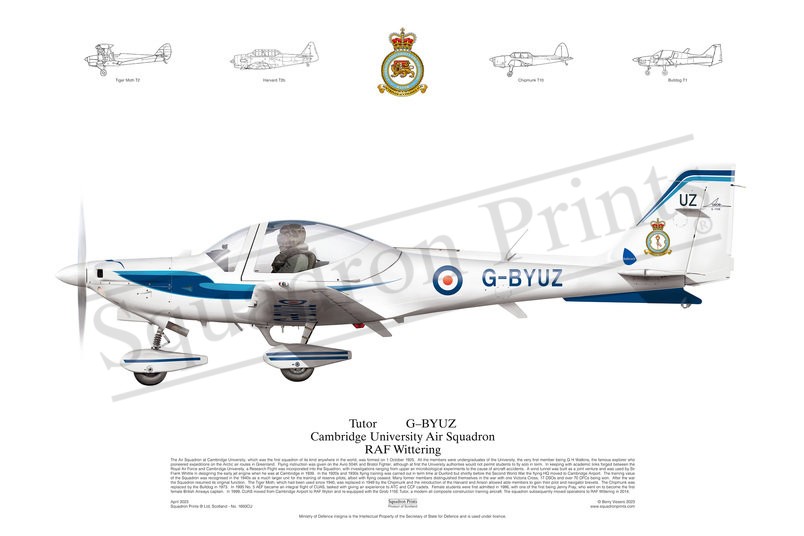#1693CU Cambridge UAS Tutor print

Description
Squadron Prints Lithograph No. 1693CU - G-BYUZ, Tutor, Cambridge University Air Squadron, RAF Wittering.
The Air Squadron at Cambridge University, which was the first squadron of its kind anywhere in the world, was formed on 1 October 1925. All the members were undergraduates of the University, the very first member being G H Watkins, the famous explorer who pioneered expeditions on the Arctic air routes in Greenland. Flying instruction was given on the Avro 504K and Bristol Fighter, although at first the University authorities would not permit students to fly solo in term. In keeping with academic links forged between the Royal Air Force and Cambridge University, a Research Flight was incorporated into the Squadron, with investigations ranging from upper air microbiological experiments to the cause of aircraft accidents. A wind tunnel was built as a joint venture and was used by Sir Frank Whittle in designing the early jet engine when he was at Cambridge in 1939. In the 1920s and 1930s flying training was carried out in term time at Duxford but shortly before the Second World War the flying HQ moved to Cambridge Airport. The training value of the Squadron was recognised in the 1940s as a much larger unit for the training of reserve pilots, albeit with flying ceased. Many former members distinguished themselves in the war with one Victoria Cross, 17 DSOs and over 70 DFCs being won. After the war the Squadron resumed its original function. The Tiger Moth, which had been used since 1940, was replaced in 1949 by the Chipmunk and the introduction of the Harvard and Anson allowed able members to gain their pilot and navigator brevets. The Chipmunk was replaced by the Bulldog in 1973. In 1995 No. 5 AEF became an integral flight of CUAS, tasked with giving air experience to ATC and CCF cadets. Female students were first admitted in 1986, with one of the first being Jenny Fray, who went on to become the first female British Airways captain. In 1999, CUAS moved from Cambridge Airport to RAF Wyton and re-equipped with the Grob 115E Tutor, a modern all composite construction training aircraft. The squadron subsequently moved operations to RAF Wittering in 2014.
You may also like
-
Hawk T1A - The Red Arrows 2020 Signed print
XX244The Red ArrowsRAF Scampton -
#617Signedpainting Miscellaneous(Special Delivery)
617 Squadron "Op Fortis" Painting - 7 Signatures
617 SqnRAF Marham; HMS Queen Elizabeth -
Spitfire and Typhoon
P7350 'EB-G'; ZK349 'GN-A'41 Sqn; 29 Sqn; BBMF; 249 SqnRAF Coningsby
